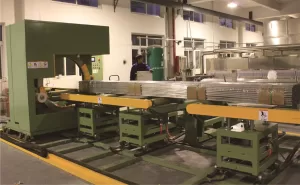Optimizing Protection: An Introduction to Automatic Horizontal Partial Wrapping Machines
Efficiently packaging long items like pipes, rods, or profiles presents unique challenges. Full wrapping isn't always necessary or cost-effective. This is where Automatic Horizontal Wrapping Machines designed for partial wrapping offer a specialized solution, providing targeted protection precisely where needed while conserving materials. Let's explore how these machines work and their benefits.
How Partial Horizontal Wrapping Works
These machines utilize a horizontal rotating ring or arm equipped with a film feeder. The key differentiator is the use of a Programmable Logic Controller (PLC). This allows operators to precisely define which sections of the product receive wrapping, controlling the wrap start/stop points, band width, and film tension. This selective wrapping capability is ideal for items requiring protection only at specific points, such as ends or contact areas.
Key Features and Technical Specifications

Note: The specifications listed below are representative. For precise details matching the machine shown or your specific requirements, please consult the manufacturer.
- Wrapping Type: Partial Horizontal Wrapping
- Film Compatibility: Suitable for PE, PVC, Stretch Film
- Wrap Position Control: Programmable via PLC
- Maximum Product Length: Typically unlimited (depends on conveyor setup)
- Product Diameter Range: Example: 50mm to 500 mm (Varies by model)
- Wrapping Speed: Example: Up to 15 RPM (Model dependent)
- Power Requirements: Example: 240V, 50Hz, single phase (Check specific model)
- Machine Footprint (Approx.): Length: 2800mm; Width: 1600mm; Height: 1400mm
- Operation Mode: Available in Semi-automatic or Fully Automatic
- Safety: Equipped with Emergency Stops and Safety Guarding
Core Advantages of Selective Wrapping
- Material Savings: Significantly reduces film consumption compared to full wrapping, lowering material costs.
- Targeted Protection: Applies wrap only where necessary, safeguarding vulnerable areas against abrasion, moisture, and handling damage.
- Increased Efficiency: Streamlines the packaging process for specific product types.
- Cost-Effectiveness: Lower material usage and potentially faster cycle times (depending on wrap length) contribute to overall cost savings.
Practical Applications Across Industries

- Metal & Plastics Fabrication: Protecting ends or specific sections of pipes, tubes, rods, extrusions, and profiles during shipping and handling.
- Lumber and Wood Products: Wrapping bundles of lumber, dowels, or mouldings, often focusing on the ends to prevent splitting or damage.
- Automotive Components: Securing items like exhaust pipes, axles, or beams, ensuring critical surfaces remain unscratched.
- Furniture Manufacturing: Protecting finished surfaces on components like table legs, chair frames, or long panels without wrapping the entire piece.
Learn more about Automatic Horizontal Wrapping Machines (Partial Wrapping)